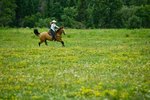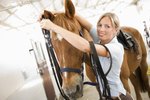
Horses rear as a way to avoid going forward, either because they are feeling stubborn or lazy, or they are in pain. Typically the horse begins by refusing to proceed, and if you push the issue, Rowdy goes up to avoid moving forward. Rowdy may tentatively lift one or both of his front feet off the ground or he may stand straight up on his back legs, but regardless of how high he goes, rearing is a serious training issue.
On the Ground
A horse that rears while you are leading him puts you in a vulnerable position. Your head is awfully close to Shasta’s front feet when she goes up in the air. To stay safe, stay as close to Shasta's shoulder as possible when she goes up. You may feel safer if you take a step or two backwards, but that puts you within range of her flailing front feet. By staying as close to her shoulder as possible, she is less likely to strike you with her feet, and if she does, the closer you are, the less force there will be behind the movement.
In the Saddle
Not reacting properly when Buck rears under saddle can create devastating injuries for both Buck and you. A horse that goes straight up in the air is at risk for going over backwards, and with the added weight of a rider on his back, Buck may lose his balance and topple over unintentionally. If Buck rears while you are on his back, lean forward, so your weight doesn't pull him off balance. Lean against the crest of his neck, to one side, so that he doesn't hit you in the face with his head, and don't pull back on the reins. If you feel secure enough, you can tug gently on one rein, which will encourage him to come down and circle. If you don't feel secure enough to do that, simply lean forward and keep slack in the reins until Buck comes down on his own.
Preventing the Problem
The best way to deal with a rearing horse is to prevent him from going up in the first place. If Folly has only shown tentative interest in rearing as a method of avoiding work, you may be able to stop the behavior by changing how you work with him. Because rearing is a method of avoiding going forward, you can prevent it by having some fail-safe methods to keep Folly moving.
The easiest way to encourage a balky horse to move along is by moving him sideways. Whether on the ground or under saddle, practice working in circles, and teach him to move away from pressure on his shoulder or sides by moving his feet over. Once you get his feet moving, it is much easier to get him moving forward.
Work with a Trainer
Rearing can be a deadly problem. If, at any point, you feel unsafe around your horse or the rearing becomes more frequent, seek professional help. An experienced trainer can help pinpoint the cause of the rearing -- which may be stubbornness or laziness on your horse's behalf or a reaction to pain -- and work with your horse to put a stop to the behavior. Chronic rearing is not the sort of training problem you should feel compelled to work through on your own.
References
Photo Credits
-
Thomas Northcut/Lifesize/Getty Images



